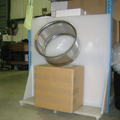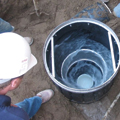This starting point is critical in developing a properly functioning and effective system.

In January’s article “Rainwater Harvesting 101,” certain issues regarding the quality of rainwater as it is collected and stored in a cistern were discussed.
The central premise, as stated then, is the overall health of a rainwater harvesting starts with the cistern. This article and subsequent installments will discuss methods engineers may employ to design an effective and cost-efficient rainwater harvesting system.
Prior to the cistern, there are two practical ways to promote the good, aerobic microbial process and discourage the bad, anaerobic microbial process in cisterns. First, the water needs to be oxygenated. This starts with encouraging the mixture of water with air when it is captured. Second, organic content of the water needs to be minimized. If the aerobic process consumes most of the organic content and produces carbon dioxide, few organics will be left to support anaerobic microbial growth.
Certain rainwater harvesting devices using self-cleaning mesh screens promote both of these goals. The screening process promotes air and water mixing while separating both inorganic and organic solids. This screening takes place not only during the course of a rainfall event, but most importantly during the first few minutes of a rainfall event where the BOD load in the water is the highest. If anything, this “first flush” effect is the most critical step of all as it disposes the bulk of BOD burden before it gets into the cistern.
Mesh screen devices using a cross-flow pattern are very effective for rainwater harvesting. They allow debris to wash through in a sheet flow for disposal without trapping it and becoming restricted without frequent cleaning. The sheet flow that naturally develops in the piping above the filter device allows the water to evenly flow across the vertical mesh screen. The natural tendency of water’s surface tension causes the water to draw through the screen and out the discharge that is extended to the cistern inlet.

Additional device options
Because not all roof drainage systems or conditions lend themselves to vertical filter devices, other devices with horizontal inlets and outlets are available. Devices with a horizontal inlet cannot take advantage of the sheet flow and water that naturally develops in a vertical stack. Therefore, the inlets to these devices are configured in such a way to allow the incoming water to distribute more evenly within the upper housing prior to washing down across the vertical mesh screen. Such horizontal inlets are configured where the inlet is placed tangentially with the outer wall of the upper housing instead of placed at the device center line.
By allowing the water to enter at a tangent to the inner wall of the upper housing, the water tends to travel around the circumference of the inner wall as it simultaneously flows downward toward the mesh screen. This allows an even sheet flow to develop as the water drops along the mesh screen.
This tangential entry and the resulting “swirling” pattern that the water initially follows are similar to how water might flow into a drain and is likened to a “vortex” action. As a result, manufacturers of horizontal devices are given the nickname “vortex filters.” However, this is a misnomer as it gives the impression the vortex is the underlying principle of the device to separate solids from the rainwater using centrifugal force. This is not the case. In fact, the so-called vortex pattern’s purpose is to establish a more uniform and stable (calmer) flow around the circumference of the upper housing before washing down and across the mesh screen. The mesh screen would otherwise be incapable of working without this uniform vertical flow.
Note the tangential entry of the water at the top in the above photo. The screen at the center of the housing is not clearly visible, but the swirling action of the water brings the water stream around the entire circumference to allow the water to pass along the surface of the screen. Note also that this screen has no bottom. That is, it does not function as a basket strainer that retains debris. This debris is discharged out the bottom of the device. The white circle at the bottom of the housing is the discharge elbow at the outlet, which is typically piped to the site storm drainage system. As a result, this type of device never inhibits the flow of water in a roof drainage system, which is an important safety feature.

Keep in mind that in any application, the vertical mesh screen is intended to collect water during low and average rainfall events. It is not intended to function efficiently during so-called dimensional rain storms. These storms are typically the 100-year, 60-minute rainfall rates used in plumbing codes to size the drainage piping. The collection devices, however, are not designed to collect water at such a rate. The mesh screen is intended to manage a lower flow rate typical of storms when it rains, for example, 0.5 in. to 1 in. a day.
It is important to appreciate that vertical mesh screen collection devices are not basket strainers or other filter devices that capture or trap debris. Any device that traps debris would require frequent cleaning and would pose a possible restriction or obstruction to the flow of storm water off a roof. In addition, the trapping of organic debris works against the goal of reducing the effects of decomposition on the quality of the water. Water washing across the trapped debris would carry away the byproducts of decomposition as well as bacteria and into the cistern. The wall of the screen is a fine mesh of about 280 to 380 micron pore size through which water is drawn. Any solids in the water stream pass across the mesh and out the bottom to a point of disposal.
The action of the water passing across the mesh screen promotes the mixture of the water with air, thereby providing dissolved oxygen content. The addition of oxygen to the water is an important part of the initial treatment process. One way to think of these mesh screen devices is they add oxygen but reduce nutrients entering the cistern. This provides the good aerobic microbes a means to “breathe” but puts them on a diet.
Now that the harvested rain has passed through an effective device to remove organics, debris and add oxygen, the next steps include how to introduce the water into the cistern and how to transfer it out.